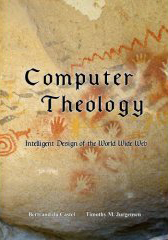PRESS
COMPUTER THEOLOGY |
||||
|
The active
components of the nervous system are the neurons. Neurons allow for the
conveyance and processing of information; information derived from the body’s
various senses, with corresponding control responses derived from this
information being formulated by collections of neurons either in the spinal
cord or in the brain, and then directed outward towards the body’s motor and
other support systems. The mechanisms effected by neurons form an organic
equivalent to an extremely complex electrical circuit. Taking a very simplistic
view, it can be observed that specifically, they roughly correspond to an
analogue circuit that provides the operations of a diode, an amplifier and a
band-pass filter; along with a wealth of processing and memory capacity. One
uses such components in the purely mechanical world to form an analog computer.
Further, from a digital computer standpoint, these are necessary elements for
gates and switches, which are essential to the logic operations of such
computers. As a basic characteristic of its physical makeup, an individual
neuron allows for the conveyance of electro-chemical representations of
information in only one direction through the cell. In a more general computer
network configuration, we would refer to this as a simplex communication
channel. So, how is this generally useful facility realized? In a most simple
overview, a neuron cell is comprised of three main components enclosed within a
common membrane: a cell body called the soma,
a collection of appendages called dendrites
and another appendage termed an axon.
There is, in general, only one axon per neuron cell, while there may be many
dendrites. The dendrites are the input channels for information into the cell
while the axon is the output channel. In its steady state, a neuron builds up a
net electrical charge across the membrane which defines the boundary of the
cell. This membrane is an insulator, composed of lipid molecules with modulated
ion channels that pass through it. Through these channels, the neuron pumps
sodium ions out of the cell and potassium ions into the cell resulting in a small
negative potential when measured on the inside of the membrane relative to the
outside of the membrane. Given a chemical stimulus through the dendrites, the
neuron can evoke an electrical discharge that is termed an action potential; a process very similar to an electrical capacitor’s
discharge. The discharge originates at the axon
hillock where the axon meets the soma. This action potential is then propagated
along the axon of the cell. At the axon’s terminus, the electrical impulse can
be conveyed to a different neuron through a very interesting chemical, not
electrical, mechanism termed a synapse. Two neurons can
be physically connected when an axon extension from one neuron, the
pre-synaptic neuron, becomes permanently attached to a different neuron, the
post-synaptic neuron. The connection point can occur at any location on the
post-synaptic neuron: on its dendrites to form an axodendritic synapse, on its soma forming an axosomatic synapse or on its axon
forming an axo-axonal synapse.
The axon from one neuron can make many connections to a single post-synaptic
neuron and it can make connections to many different post-synaptic neurons. The
attachment point of one of these axon connection points, called a terminal button,
to a post-synaptic neuron is a synapse
and the space between the pre-synaptic and post-synaptic boundaries is called
the synaptic cleft. So, for any collection of
neurons, the number of synapses can be much larger than the total number of
neurons. The total information handling capacity, a characteristic directly
related to the cognitive capacity of the brain, appears to be related to the
number of active synapses in the brain. At a synapse connection, some rather complex operations are activated through which information is passed from one neuron to another. An action potential within a neuron, when it reaches the terminal button of the axon, causes the release of one or more of a variety of chemicals termed neurotransmitters. Neurotransmitters are able to cross the synaptic boundary to the post-synaptic neuron. As regulated by this post-synaptic neuron, the neurotransmitter material may tend to |
||||
|
||||
© Midori Press, LLC, 2008. All rights reserved for all countries. (Inquiries) The contents of ComputerTheology: Intelligent Design of the World Wide Web are presented for the sole purpose of on-line reading to allow the reader to determine whether to purchase the book. Reproduction and other derivative works are expressly forbidden without the written consent of Midori Press. Legal deposit with the US Library of Congress 1-33735636, 2007.
|
ComputerTheology Intelligent Design of the World Wide Web Bertrand du Castel and Timothy M. Jurgensen Midori Press, Austin Texas 1st Edition 2008 (468 pp) ISBN 0-9801821-1-5 |
Book available at Midori Press (regular) |
